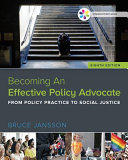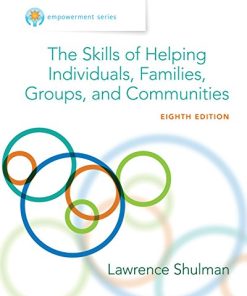(Ebook PDF) Empowerment Series Becoming An Effective Policy Advocate 8th Edition by Bruce Jansson ISBN 9798214338224 130594335X full chapters
$50.00 Original price was: $50.00.$25.00Current price is: $25.00.
(Ebook PDF) Empowerment Series Becoming An Effective Policy Advocate 8th Edition by Bruce Jansson-Ebook PDF Instant Download/Delivery:9798214338224, 130594335X
Instant download Full Chapter of Empowerment Series Becoming An Effective Policy Advocate 8th Edition after payment

Product details:
ISBN 10: 130594335X
ISBN 13: 9798214338224
Author: Bruce S. Jansson
Table of contents:
Part 1. Becoming Motivated to Become a Policy Advocate and a Leader
- Chapter 1. Joining a Tradition of Social Reform
- Focus of This Book: A Hands-On Framework for Reforming Policies
- Diversity and Policy Advocacy
- Advancing the Public Interest at Home and Abroad
- Using an Ecological Perspective
- What Policy Practitioners and Policy Advocates Seek to Change
- Policy Advocacy as a Developmental Process
- Challenges Encountered by Policy Advocates
- A Crowded Field
- Influencing Tangible Interests of Persons, Groups, and Corporations
- Divergent Values and Ideologies
- Making Time Commitments to Policy Advocacy
- Globalization and Policy Advocacy
- Becoming an Effective Policy Advocate
- Developing a Vision
- Seeking Opportunities for Policy Advocacy
- Taking Sensible Risks
- Balancing Flexibility with Planning
- Being Appropriately Assertive
- Developing Multiple Skills
- Being Persistent
- Tolerating Uncertainty
- Combining Pragmatism with Principles
- The Rewards of Policy Advocacy
- Changing the Composition of Legislators, Presidents, and Governors
- Getting Started
- Becoming Leaders
- Joining the Reform Tradition Within Social Work
- Chapter Summary
- Competency Notes
- Suggested Readings
- Chapter 2. Articulating Four Rationales for Participating in Policy Advocacy
- Policy Advocacy at Three Levels
- The Ethical Rationale for Policy Advocacy
- Policy Advocacy, Powerless Groups, and Social Justice
- Policy Advocacy for Vulnerable Populations
- Other Ethical Principles in Policy Advocacy
- Other Types of Ethical Reasoning
- Toward an Eclectic Approach to Ethical Reasoning
- Returning to Divergent Values and Ideologies
- Ethical Imperatives at Micro, Mezzo, and Macro Policy Advocacy Levels
- Ethical Imperatives in Micro Policy Advocacy
- Beneficence and Professional Practice
- Ethical Imperatives in Mezzo Policy Advocacy
- Ethical Imperatives in Macro Policy Advocacy
- The Analytic Rationale for Policy Advocacy
- Choosing Sides: Controversy and Research
- The Political Rationale for Policy Advocacy
- The Electoral Rationale for Policy Advocacy
- Linking the Four Rationales for Policy Advocacy to Homelessness
- Interlocking Rationales for Policy Advocacy
- Chapter Summary
- Competency Notes
- Suggested Readings
Part 2. Surmounting Cynicism by Developing Policy-Advocacy Skills
- Chapter 3. Obtaining Skills and Competencies for Policy Advocacy
- A Policy-Practice Framework
- The Policy Context for Policy Advocacy at Micro, Mezzo, and Macro Levels
- Contextual Factors in Micro Policy Advocacy and Mezzo Policy Advocacy
- Perspectives of Stakeholders and Policy Advocates
- Patterns of Participation
- The Eight Tasks of Policy Advocates
- Four Skills That Policy Practitioners Need
- Policy Competencies
- Styles of Policy Practice
- Applications of Policy Tasks and Skills
- Ballot-Based Advocacy
- The Variety of Policies
- Overcoming Discomfort with Power
- Social Policy’s Role in Ecological Frameworks
- Policy Practice as a Unifying Theme
- Chapter Summary
- Competency Notes
- Suggested Readings
Part 3. The Ecology of Policy in the United States and in a Global World
- Chapter 4. Understanding the Ecology of Policy in Governmental, Electoral, Community, and Agency Settings
- Macro Policy Advocacy: The Players in Legislative and Governmental Settings
- Elected Officials
- Unelected Officials or Bureaucrats
- Lobbyists and Interest Groups
- Connections among Interest Groups, Legislators, and Bureaucrats
- Public Opinion
- Advocacy Groups
- The Electoral Process
- Early Maneuvering
- Running Campaigns
- The Mindsets of Elected Officials
- The Environment of Public Servants: Elected Officials
- Shortcuts: Aides, Lobbyists, and Priorities
- The Calculus of Choice
- The Mindsets of Nonelected Officials
- Political Appointees
- Civil Servants
- Strategy in Legislative Settings
- Advocating for Resources
- The Law and Social Policy
- Micro and Mezzo Policy Advocacy: The Political Economy of Social Agencies
- The Political Economy of Programs and Social Work Units
- Mapping Agencies’ Policies
- The Players in Organizational Settings
- Overlay 1: The Organizational Chart
- Overlay 2: Budget Priorities
- Overlay 3: Boundary Spanners and Mission Enhancers
- Overlay 4: Informal Relationships among Organizational Members
- Micro and Mezzo Policy Advocacy: The Political Economy of Communities
- Different Layers of Government and Policy
- Maneuvering in a Multilayered Policy Ecology
- Chapter Summary
- Competency Notes
- Suggested Readings
- Chapter 5. Expanding Policy Advocacy across National Borders
- Social Problems in an Interdependent World
- Why Globalization Sometimes Harms Vulnerable Populations in the United States
- Why an Economic Gap Developed between Developing and Developed Nations
- Why Globalization Sometimes Harms Vulnerable Populations in Developing Nations
- Another Vulnerable Population: Migrants Within and between Nations
- Ideological Conflict Over Immigration
- Globalization’s Impact on the Environment
- Threats to Public Health
- Creating a Monoculture?
- The Great Caveat: Globalization’s Positive Effects
- Policy Advocacy for Populations Harmed by Globalization
- Policy Options in the United States
- Policy Options to Help Vulnerable Populations Abroad
- Protecting Human Rights
- Surmounting Natural Disasters
- Crucial Role of Nongovernmental Organizations
- Chapter Summary
- Competency Notes
- Suggested Readings
Part 4. Committing to Problems and Solutions by Building Policy Agendas and Engaging in Policy Analysis
- Chapter 6. Committing to an Issue: Building Agendas
- Taking the First Step
- Why Agenda Building Is Needed
- Legislatures
- Agencies
- Communities
- Elections
- Three Challenges in Agenda Building
- The Diagnosing or Listening Stage
- The Softening or Moderating Stage
- The Activating Stage
- Can Direct-Service Staff Help Build Agendas?
- Policy Advocacy for Powerless Populations and Unpopular Issues
- Electoral Processes
- Developing Links with Advocacy Groups
- Using Multiple Skills in Agenda Building
- Chapter Summary
- Competency Notes
- Suggested Readings
- Chapter 7. Analyzing Problems in the First Step of Policy Analysis
- Putting It All Together: A Six-Step Policy Analysis Framework
- A Six-Step Policy Analysis, Proposal-Writing, and Presentation Framework
- Do Policy Advocates Have to Analyze Problems?
- Using a Flowchart to Analyze Some Social Problems in Step 1
- Using a Flowchart in Step 1
- Illustrating a Flowchart with Welfare Reform
- Analyzing the Causes of Social Problems in Step 1
- Developing Interventions and Programs in Step 1
- Developing Preventive Programs in Step 1
- Measuring the Magnitude of Problems in Step 1
- Locating Problems Spatially in Step 1
- Understanding Social Problems as Slippery Concepts in Step 1
- When Are Social Problems Real, and When Are They Invented?
- Many Social Problems Defy Simple Solutions, but Many People Favor Panaceas
- Priorities Are Not Chosen Rationally
- Solving One Problem Can Create Others
- Variations in Problems
- Challenges for Policy Advocates in Step 1
- Chapter Summary
- Competency Notes
- Suggested Readings
- Chapter 8. Placing Policy Proposals in Policy Briefs in the Second, Third, and Fourth Steps of Policy Analysis
- Returning to the Six-Step Policy Analysis, Proposal-Writing, and Presentation Framework with Steps 2, 3, and 4
- Intersecting Arenas and Stakeholders
- Identifying Recurring Policy Issues and Policy Options in Steps 2, 3, and 4
- Establishing a Mission in Steps 2, 3, and 4
- Designing the Structure of Service in Steps 2, 3, and 4
- Planning the Extent of Devolution and the Resource Path in Steps 2, 3, and 4
- Determining Levels of Funds
- Funding Channels
- Indirect Financing
- Defining Services in Steps 2, 3, and 4
- Establishing an Orienting Framework
- Staff and Licensing
- Preventive versus Curative Services
- Rationing Scarce Resources in Steps 2, 3, and 4
- Formal or Direct Methods of Rationing
- Indirect Methods of Restricting Access
- Addressing Agency Network Issues in Steps 2, 3, and 4
- Addressing Community Factors in Steps 2, 3, and 4
- Guiding and Overseeing Policy Implementation in Steps 2, 3, and 4
- Assessing Implemented Policies in Steps 2, 3, and 4
- An Overview of a Policy Brief or Proposal to Fund Domestic Violence Shelters
- The Anatomy of Policy Briefs or Proposals
- Trade-Offs: Systematically Comparing Policy Options in Step 3
- Identifying Options in Step 2
- Selecting and Weighing Criteria in Step 3
- Creating a Decision-Making Matrix in Step 3
- Qualitative Rankings
- Using Different Policy Skills in Tandem in Steps 2, 3, and 4
- The Basic Content of a Policy Proposal Described by a Policy Brief
- Chapter Summary
- Competency Notes
- Suggested Readings
- Professional and Staffing Issues
- Allocation Issues
- Prevention
- Staff Discretion
- Policy Analysis
- Chapter 9. Presenting and Defending Policy Proposals in Step 5 and Step 6 of Policy Analysis
- Ideology and Policy Positions in Step 5 and Step 6
- Proposals and Ideology
- Electoral Politics and Proposals in Step 5 and Step 6
- Combative Persuasion in Step 5 and Step 6
- Adversarial Debates in Step 5 and Step 6
- Coercive Messages in Step 5 and Step 6
- Negotiations: Hardball and Win–Win Options in Step 5 and Step 6
- Adversarial or Friendly Communication: Which Is Preferable in Step 5 and Step 6?
- Persuading Specific Audiences in Step 5 and Step 6
- Determining Objectives
- Diagnosing Audiences
- Strategies of Persuasion in Step 5 and Step 6
- Selecting a Medium
- Using a Sequence of Presentations
- Selecting a Format
- Developing an Effective Presentation Style
- Tactics for Specific Audiences
- Other Tactical Choices
- Assembling a Strategy in Step 5 and Step 6
- The Hostile Audience
- The Sympathetic Audience with Some Hostile Members
- The Expert Audience
- Motivational Strategies
- Interpersonal Discussions
- Communicating with Funders
- Using Powerpoint to Get Support from Decision Makers
- Chapter Summary
- Competency Notes
- Suggested Readings
Part 5. Advocating for Change
- Chapter 10. Developing and Using Power in the Policy-Enacting Task
- In Defense of Politics
- Analytic and Political Approaches to Policy Advocacy
- The Nature of Power in the Policy-Enacting Task
- Person-to-Person Power in the Policy-Enacting Task
- Power Resources That Stem from Policy Maneuvering in the Policy-Enacting Task
- Substantive Power
- Power in Decision-Making Procedures
- Process Power
- Shaping Contexts Including Use of the Internet
- Successful Power Users in the Policy-Enacting Task
- Power in Organizations in the Policy-Enacting Task
- Discretion, Compliance, and Whistleblowing
- Defining Zones of Discretion
- Issues of Compliance
- Whistleblowing
- Power Differentials in the Policy-Enacting Task
- Ethical Issues in the Policy-Enacting Task
- Engaging in the Policy-Enacting Task in Situations Where Advocates Are Disadvantaged as Compared to More Powerful Players
- Obtaining Power Resources in the Policy-Enacting Task
- Building Personal Credibility
- Networking
- Power Challenges Encountered by Members of Vulnerable Populations in the Policy-Enacting Task
- Becoming Appropriately Assertive in the Policy-Enacting Task
- Illustration from Policy Advocacy Challenge 10.7
- Can Direct-Service Staff Use Power Resources in the Policy-Enacting Task?
- Chapter Summary
- Competency Notes
- Suggested Readings
- Chapter 11. Developing Political Strategy and Putting It into Action in the Policy-Enacting Task
- Establishing Some Objectives in the Policy-Enacting Task
- Determining a Position
- Selecting the Extent of Policy Changes
- Selecting a Time Frame
- Grounding Strategy in Current Realities in the Policy-Enacting Task
- The Power Distribution
- Identifying Contextual Factors
- Past Stances
- Vested Interests
- Cohesion of Likely Opponents and Proponents
- Situational Realities
- Adapting Strategy to the Setting
- Developing Alternative Scenarios
- Selecting a Strategy
- Revising the Strategy
- Seven Recurring Steps in Strategy in the Policy-Enacting Task
- Organizing a Team or Coalition
- Establishing Policy Goals
- Specifying a Proposal’s Content and Getting Early Sponsors
- Establishing a Style
- Selecting Power Resources and Framing Strategy
- Implementing Strategy
- Revising the Strategy
- A Policy Advocacy Challenge: How to Block Ill-Advised Policy Proposals in the Policy-Enacting Task
- Strategy in Legislative Settings
- Organizing Legislative Advocacy Projects in the Policy-Enacting Task
- Organizing a Team or Coalition
- Establishing Policy Goals in a Legislative Context
- Writing a Policy Brief: Specifying a Proposal’s Content and Getting Early Sponsors
- Establishing a Style in the Policy-Enacting Task
- Selecting Power Resources and Framing Strategy
- Implementing Strategy
- Revising the Strategy
- Strategy in Agency Settings in the Policy-Enacting Task
- Organizing a Team or Coalition
- Establishing Policy Goals in the Organizational Context
- Specifying a Proposal’s Content
- Establishing a Style
- Selecting Power Resources and Framing Strategy
- Revising the Strategy
- Developing Strategy in Community Settings in the Policy-Enacting Task
- Establishing Policy Goals in the Community Context
- Specifying a Proposal’s Content
- Establishing a Style
- Selecting Power Resources and Framing Strategy
- Revising the Strategy
- Using Task Groups in the Policy-Enacting Task
- Why Develop Task Groups?
- Policy Advocates’ Roles in Task Groups
- What Successful Task Groups Need
- The Task Group’s Mission
- The Task Group’s Leadership
- The Task Group’s Developmental Needs
- The Task Group’s Procedures
- The Task Group’s Structure
- The Task Group’s Deliberative and Interactional Processes
- The Task Group’s Staff and Resources
- Forming Coalitions in the Policy-Enacting Task
- Establishing Networks in the Policy-Enacting Task
- Addressing Dysfunctional Group Processes
- An Advocacy Campaign in Sacramento, California
- Chapter Summary
- Competency Notes
- Suggested Readings
- Chapter 12. Engaging in Ballot-Based Policy Advocacy
- Why Ballot-Based Policy Advocacy Is Important?
- The High Stakes in 2016
- The Limits of Electoral Politics and the Two-Party System
- Developing Population Profiles
- Using Power Resources to Persuade Voters
- Using One-on-One Power Resources
- Using the Media
- Interacting with Opposing Candidates in Public Forums
- Developing Positions on Issues and Demonstrating Positive Personal Qualities
- Conducting Negative Attacks on Opponents
- Getting out the Vote
- Securing Endorsements
- Convincing Other Potential Candidates Not to Run
- Gaining Support from Party, Trade Unions, and Other Groups
- Finding Resources
- Creating a Campaign Organization
- Developing Campaign Strategy: Strategy Options at the Outset of a Campaign
- Strategy during the Mid-Phase of a Campaign
- End-Game Strategy
- Conducting Issue-Oriented Campaigns
- Making Issue Campaigns and Electoral Politics Intersect
- Participating in Electoral and Issue-Oriented Campaigns
- Deciding to Run for Office
- Selecting Other Public-Service Positions
- Why Social Policy Often Hinges on Elections?
- Chapter Summary
- Competency Notes
- Suggested Readings
Part 6. Troubleshooting and Assessing Policies
- Chapter 13. Troubleshooting the Implementation of Policies in Task 7
- A Framework for Implementing Policy in Task 7
- The Context of Implementation
- Policy Innovations or Major New Initiatives
- Oversight Organizations and Staff
- Primary Implementing Organizations
- Interorganizational Processes
- Diagnosing Implementing Processes
- Actual Outputs: Assessment of Implemented Policies
- Reforming the Implementation Process in Task 7
- Amending the Policy Innovation
- Do Policy Advocates Ever Sabotage Policies?
- Case Study of Implementation
- Chapter Summary
- Competency Notes
- Suggested Readings
- Chapter 14. Assessing Policy: Toward Evidence-Based Policy during Task 8
- The Rationalists’ Hope
- Defining Evidence-Based Policies
- Why Supportive Policies Are Needed for Evidence-Based Practices
- Policy Assessment as Argumentation
- Some Technical Tools
- Countering Innuendos That Lack a Basis in Research
- Some Barriers to Evidence-Based Policies
- Remarkable Policy Successes
- Returning to Values
- Chapter Summary
People also search:
empowerment series becoming an effective policy advocate 8th edition
empowerment series becoming an effective policy advocate 8th edition pdf
how to be an effective advocate
empowerment series social welfare policy and social programs
empowerment series social welfare policy and social programs enhanced
Tags:
Empowerment Series,Effective Policy Advocate,Bruce Jansson
You may also like…
Uncategorized
Empowerment Series: An Introduction to the Profession of Social Work 5th Edition, (Ebook PDF)
Uncategorized
Uncategorized
Arts - History & Criticism
Medicine
Uncategorized
Education Studies & Teaching - School Education & Teaching
Empowerment Series: An Introduction to the Profession of Social Work 6th Edition
Uncategorized












